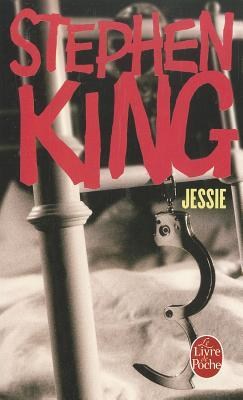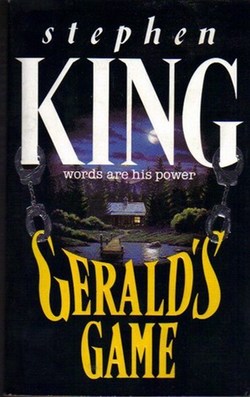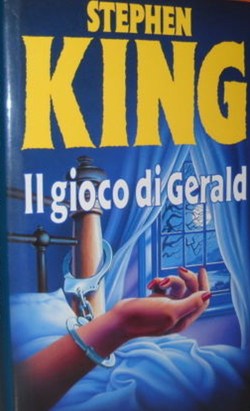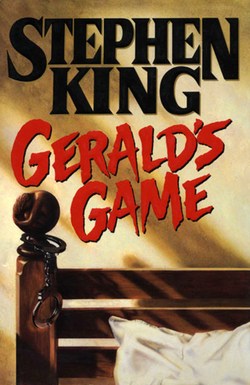By 1992, Stephen King was getting slippery. After his publishers spent a lot of time and money reassuring readers that Stephen King was, indeed, “The Master of Horror” with Four Past Midnight and Needful Things, King flipped the script and delivered two books in 1992 that were about girls. Not just girls, but girls who didn’t do anything particularly horrifying.
Gerald’s Game (May, 1992) and Dolores Claiborne (November, 1992) were about the development of feminist consciousness, the crimes of the patriarchy, incest, and domestic abuse. That’s a far cry from possessed cars, rabid dogs, and daddies with roque mallets chasing their kids down hotel hallways. But despite their ambitions, both books stand as a testament to what might have been if King had only been a little bit more ambitious. If he had just reached a little further, these two books could have been his masterpiece.
Originally intended to be two halves of a single novel called In the Path of the Eclipse, both Gerald’s Game and Dolores Claiborne feel like King’s answer to critics who accused him of being unable to write women. King writes a lot of women, and in general he does it very well because he writes them just like he writes men, but when you look at Bobbi Andersen (The Tommyknockers, possessed by aliens), Annie Wilkes (Misery, a psychopath), Heidi Halleck (Thinner, an adulturer), Christine (Christine, an evil car), Donna Trenton (Cujo, adulturer, bad mother) you can see where critics find their ammunition for this charge. It’s just sort of lying around. Enter Gerald’s Game, the anti-Fifty Shades of Grey.
 Jessie Burlingame is 39 years old, a trophy wife for her rich attorney husband, Gerald. They don’t have kids, and while their marriage seems okay, there aren’t many fireworks. Gerald’s been trying to spice things up in the bedroom by handcuffing Jessie to the bed and having sex with her while she pretends to be helpless. She goes along with it, the way she goes along with just about everything else in their marriage, with a sort of halfhearted tolerance. The book opens with the two of them at their remote lake house by Lake Kashwakamak, Jessie in her panties, arms handcuffed to the headboard, deciding that she’s changed her mind and doesn’t want to play Gerald’s game anymore. He decides to rape her anyways, she kicks him in the balls, he has a massive heart attack, and dies.
Jessie Burlingame is 39 years old, a trophy wife for her rich attorney husband, Gerald. They don’t have kids, and while their marriage seems okay, there aren’t many fireworks. Gerald’s been trying to spice things up in the bedroom by handcuffing Jessie to the bed and having sex with her while she pretends to be helpless. She goes along with it, the way she goes along with just about everything else in their marriage, with a sort of halfhearted tolerance. The book opens with the two of them at their remote lake house by Lake Kashwakamak, Jessie in her panties, arms handcuffed to the headboard, deciding that she’s changed her mind and doesn’t want to play Gerald’s game anymore. He decides to rape her anyways, she kicks him in the balls, he has a massive heart attack, and dies.
Having finally stood up for herself and gotten nothing but a dead husband for her efforts, Jessie’s in a tight spot. The book unfolds over the next two days as she battle thirst, hallucinations, and worse in her attempts to escape from his handcuffs. Thrown into the mix are Prince, a stray dog starving to death after being abandoned in the nearby woods, who comes into the house to munch on her husband’s corpse, and “The Space Cowboy”, a mysterious, malformed man who appears in the moonlight in the corner of her room at night who may or may not be a necrophiliac, cannibal corpse mutilator. Or he might just be a hallucination. In the end, Jessie escapes via a horrendous bit of self-mutilation that’s known in medical circles as a “de-gloving” and she makes it to safety.
 Accompanying her imprisonment are a chorus of voices inside her head: a good girl, a therapist, and the voice of a college friend, Ruth, who might have become her lover if Jessie had been more self-actualized. They torment and assist Jessie in equal part, putting her on trial for being nothing more than an accessory to her husband. In the course of their inner monologue, Jessie is dragged back to the memories of a 1963 solar eclipse when her father sexually molested her. It’s only by dealing with this memory of her victimization as a ten-year-old that she finds the strength to de-glove what needs to be de-gloved and escape her handcuffs as an adult. Cue the Mighty Metaphor Medley.
Accompanying her imprisonment are a chorus of voices inside her head: a good girl, a therapist, and the voice of a college friend, Ruth, who might have become her lover if Jessie had been more self-actualized. They torment and assist Jessie in equal part, putting her on trial for being nothing more than an accessory to her husband. In the course of their inner monologue, Jessie is dragged back to the memories of a 1963 solar eclipse when her father sexually molested her. It’s only by dealing with this memory of her victimization as a ten-year-old that she finds the strength to de-glove what needs to be de-gloved and escape her handcuffs as an adult. Cue the Mighty Metaphor Medley.
Gerald’s Game is the logical conclusion of King’s obsession with limited locations. The Shining saw three people trapped in a hotel. Cujo had two people trapped in a Pinto. Misery had two people trapped in a small house. And now Gerald’s Game features one woman trapped in a room. It spent nine weeks at #1 on the New York Times hardcover bestseller list, but only made it to #5 on the softcover bestseller list, one of King’s few books not to hit the top of both charts. It’s easy to see why. King himself acknowledged that this was a very diffferent book for him to write in a USA Today interview, saying:
When I write, I want to scare people, but there is a certain comfort level for the reader because you are aware all the time that it’s make-believe. Vampires, the supernatural and all that….But these last two books [Dolores Claiborne and Gerald’s Game] take people out of the safety zone and that, in a way, is even scarier.
But for most people the scariest thing about this book was that it was written by Stephen King. The New York Times review summed up all the critical hand-wringing best, fretting itself into a breathless swoon:
Did Stephen King take on these heavy themes to prove that he is a Real Writer, not just a horror writer? Was he trying to shift from writing good bad novels to writing good good novels, and ended up with a bad good novel? The two genres cancel each other out: the horror makes us distrust the serious theme, and the serious theme stops us from suspending our disbelief to savor the horror.
Eek! There’s a horror writer in our Serious Themes house!
 Entertainment Weekly was a lot more succinct, accusing King of ruining a good story with “stick-on feminism” and they have a point since there is a certain paint-by-numbers aspect to Jesssie’s psychological liberation. At the same time, the book is a fascinating and necessary (if somewhat crude) response to a kind of sex positivism that at times threatens to become a cudgel, and which finds its most conservative expression in Fifty Shades of Grey. In both Fifty Shades and Gerald’s Game, female characters find liberation in S&M, but whereas Anastasia Steele finds liberation in rejecting her past and becoming submissive to a man whom she ultimately marries, Jessie Burlingame finds liberation in rejecting her spouse’s domineering S&M interests, getting out of her marriage, and reclaiming her past. It’s a much more genuinely liberating message, although King can go a little over-the-top at times, as when Jessie claims that men are “cursed” by having a penis, as if packs of were-penises roamed the land under the full moon, biting men and changing them into were-dicks.
Entertainment Weekly was a lot more succinct, accusing King of ruining a good story with “stick-on feminism” and they have a point since there is a certain paint-by-numbers aspect to Jesssie’s psychological liberation. At the same time, the book is a fascinating and necessary (if somewhat crude) response to a kind of sex positivism that at times threatens to become a cudgel, and which finds its most conservative expression in Fifty Shades of Grey. In both Fifty Shades and Gerald’s Game, female characters find liberation in S&M, but whereas Anastasia Steele finds liberation in rejecting her past and becoming submissive to a man whom she ultimately marries, Jessie Burlingame finds liberation in rejecting her spouse’s domineering S&M interests, getting out of her marriage, and reclaiming her past. It’s a much more genuinely liberating message, although King can go a little over-the-top at times, as when Jessie claims that men are “cursed” by having a penis, as if packs of were-penises roamed the land under the full moon, biting men and changing them into were-dicks.
Some readers might be turned off by King’s on-the-nose indictment of our patriarchal society, but Gerald’s Game has other rewards, including what might be the most sustained scenes of terror King has ever written. Starting with a sequence told from Prince’s point-of-view (reinforcing the idea that King may be one of America’s great dog POV writers, see also The Stand, Cujo), then moving into the hallucinatory first appearance by the Space Cowboy, followed by Jessie’s de-gloving and escape, King turns in 200 pages whose intensity would be hard to rival, by King or anyone else. Unfortunately, it’s a 420 page book.
 Ultimately, what reduces the status of this book to B-list King is not too much ambition, but too little. A desire to write something bigger, something deeper, something about a character further removed from himself, these are the strengths of Gerald’s Game. But it’s King’s decision, made for reasons that are unclear, to abandon his less-lucrative but more ambitious plan to publish it as one half of In the Path of the Eclipse that undermines this book. As a novella, Gerald’s Game would have been all sleek meat with less introspective padding, and connecting it physically to Dolores Claiborne would have served to strengthen it. Although both books are linked by two brief psychic flashes exchanged between Jessie and Dolores (once in 1963, once in 1992), placing them between the same covers would have set their contrasting elements in starker relief.
Ultimately, what reduces the status of this book to B-list King is not too much ambition, but too little. A desire to write something bigger, something deeper, something about a character further removed from himself, these are the strengths of Gerald’s Game. But it’s King’s decision, made for reasons that are unclear, to abandon his less-lucrative but more ambitious plan to publish it as one half of In the Path of the Eclipse that undermines this book. As a novella, Gerald’s Game would have been all sleek meat with less introspective padding, and connecting it physically to Dolores Claiborne would have served to strengthen it. Although both books are linked by two brief psychic flashes exchanged between Jessie and Dolores (once in 1963, once in 1992), placing them between the same covers would have set their contrasting elements in starker relief.
Dolores is poor, hard, and blue collar; Jessie is rich, soft, and a kept woman. Both of them have to dig deep to find the strength they need to escape their abuse (domestic and sexual). Both of them are battered by men, and judged in the court of public opinion, and both of them earn qualified triumphs. In both books, King gives us an array of bad guys—the Space Cowboy, Gerald, Gerald’s law firm which worries about its public image, Dolores’s abusive husband, the town fathers of Little Tall Island who judge what Dolores does to protect her children—and standing against this gallery of patriarchal thugs is a great fellowship of women reaching from Dolores, back to her elderly boss Vera, and forward to Jessie, and even extending to the unseen Ruth who tried to help her college friend, and was rebuffed for her efforts. It’s an unofficial legion of women who look out for each other, protect each other, and share their strength in times of crisis. They stand together, because their only other option is to die separately. Split into two books, it’s a weaker story, but you can still see traces of what might have been King’s great epic about the lives of women lingering on the page.
Grady Hendrix is the author of Satan Loves You, Occupy Space, and he’s the co-author of Dirt Candy: A Cookbook, the first graphic novel cookbook. He’s written for publications ranging from Playboy to World Literature Today and his story, “Mofongo Knows” appears in the anthology, The Mad Scientist’s Guide to World Domination.










